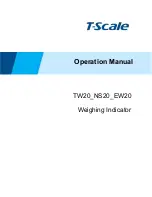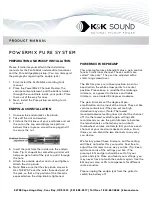
2
8.
MAX. SHUNT CURRENTS (ON CURRENT METER)
:
199.9 µA through 19.99 mA
: 10 x max. range current
199.9 mA
: 1 amp
1.999 amp
: 3 amps
Caution: In circuits where fault currents can exceed the maximum shunt
current, a fast-blow fuse should be installed in series with the input signal.
Otherwise, a slow blow 10 amp fuse is recommended that will allow for
start-up over current situations, while still protecting the instrument.
9.
TEMPERATURE COEFFICIENTS:
Current meter
Voltmeter
DC: ±100 PPM/°C
DC: ±75 PPM/°C
10.
ENVIRONMENTAL CONDITIONS
:
Operating Temperature
: 0° to 60°C
Storage Temperature
: -40° to 80°C
Operating and Storage Humidity
: 85% max. relative humidity (non-
condensing) from 0°C to 50°C.
Altitude
: Up to 2000 meters
11.
RESPONSE TIME TO STEP CHANGE INPUT
: 1 sec. nominal
12.
READING RATE
: 2.5 readings/sec., nominal
13.
NORMAL MODE REJECTION
: 50 dB 50/60 Hz
14.
COMMON MODE REJECTION
: 110 dB DC or 50/60 Hz
15.
COMMON MODE VOLTAGE (COMM. TO EARTH)
: 350 volt peak
16.
CERTIFICATIONS AND COMPLIANCES
:
CE Approved
EN 61326-1 Immunity to Industrial Locations
Emission CISPR 11 Class A
Safety requirements for electrical equipment for measurement, control, and
laboratory use:
EN 61010-1: General Requirements
Type 4 Enclosure rating (Face only)
IP65 Enclosure rating (Face only)
Refer to the EMC Installation Guidelines section of this bulletin for
additional information.
17.
CONSTRUCTION
: Metal die-cast front bezel with black, high impact
plastic case. This unit is rated for NEMA 4/IP65 indoor use when properly
installed (panel gasket and mounting clips included). Installation Category II,
Pollution Degree 2.
18.
WEIGHT
: 1.2 lbs. (0.54 Kg)
EMC INSTALLATION GUIDELINES
Although Red Lion Controls Products are designed with a high degree of
immunity to Electromagnetic Interference (EMI), proper installation and wiring
methods must be followed to ensure compatibility in each application. The type
of the electrical noise, source or coupling method into a unit may be different
for various installations. Cable length, routing, and shield termination are very
important and can mean the difference between a successful or troublesome
installation. Listed are some EMI guidelines for a successful installation in an
industrial environment.
1. A unit should be mounted in a metal enclosure, which is properly connected
to protective earth.
2. Use shielded cables for all Signal and Control inputs. The shield connection
should be made as short as possible. The connection point for the shield
depends somewhat upon the application. Listed below are the recommended
methods of connecting the shield, in order of their effectiveness.
a. Connect the shield to earth ground (protective earth) at one end where the
unit is mounted.
b. Connect the shield to earth ground at both ends of the cable, usually when
the noise source frequency is over 1 MHz.
3. Never run Signal or Control cables in the same conduit or raceway with AC
power lines, conductors, feeding motors, solenoids, SCR controls, and
heaters, etc. The cables should be run through metal conduit that is properly
grounded. This is especially useful in applications where cable runs are long
and portable two-way radios are used in close proximity or if the installation
is near a commercial radio transmitter. Also, Signal or Control cables within
an enclosure should be routed as far away as possible from contactors, control
relays, transformers, and other noisy components.
4. Long cable runs are more susceptible to EMI pickup than short cable runs.
5. In extremely high EMI environments, the use of external EMI suppression
devices such as Ferrite Suppression Cores for signal and control cables is
effective. The following EMI suppression devices (or equivalent) are
recommended:
Fair-Rite part number 0443167251 (RLC part number FCOR0000)
Line Filters for input power cables:
Schaffner # FN2010-1/07 (Red Lion Controls # LFIL0000)
6. To protect relay contacts that control inductive loads and to minimize radiated
and conducted noise (EMI), some type of contact protection network is
normally installed across the load, the contacts or both. The most effective
location is across the load.
a. Using a snubber, which is a resistor-capacitor (RC) network or metal oxide
varistor (MOV) across an AC inductive load is very effective at reducing
EMI and increasing relay contact life.
b. If a DC inductive load (such as a DC relay coil) is controlled by a transistor
switch, care must be taken not to exceed the breakdown voltage of the
transistor when the load is switched. One of the most effective ways is to
place a diode across the inductive load. Most RLC products with solid state
outputs have internal zener diode protection. However external diode
protection at the load is always a good design practice to limit EMI.
Although the use of a snubber or varistor could be used.
RLC part numbers: Snubber: SNUB0000
Varistor: ILS11500 or ILS23000
7. Care should be taken when connecting input and output devices to the
instrument. When a separate input and output common is provided, they
should not be mixed. Therefore a sensor common should NOT be connected
to an output common. This would cause EMI on the sensitive input common,
which could affect the instrument’s operation.
Visit RLC’s web site at http://www.redlion.net/Support/InstallationConsiderations.
html for more information on EMI guidelines, Safety and CE issues as they
relate to Red Lion Controls products.
WIRING CONNECTIONS
All connections are made to a removable terminal block for ease of
installation. Conductors should meet voltage and current ratings for each
terminal. Also cabling should conform to appropriate standards of good
installation, local codes and regulations. It is recommended that power supplied
to the unit be protected by a fuse or circuit breaker.
To remove the block, pull from the back of the block until it slides clear of
the terminal block shroud.
Caution
: Terminal block should
NOT
be removed
with power applied to the unit.
POWER WIRING
Primary AC power is connected to Terminals 1 and 2
(Marked A.C. Power,
located on the left-hand side of the terminal block)
. For best results, the AC
power should be relatively
“Clean”
and within the specified ±10% variation
limit. Drawing power from heavily loaded circuits or from circuits that also
power loads that cycle on and off, should be avoided.
SIGNAL WIRING
Input connections and range configuration jumpers are made on Terminals 3
through 10 or 11.
(For detailed information, see “Inputs and Configurations”.)
DECIMAL POINT SELECTION
The Apollo Volt and Current meters have DIP switches located on the side of
the unit for the selection of 1 of 3 decimal points for display.























